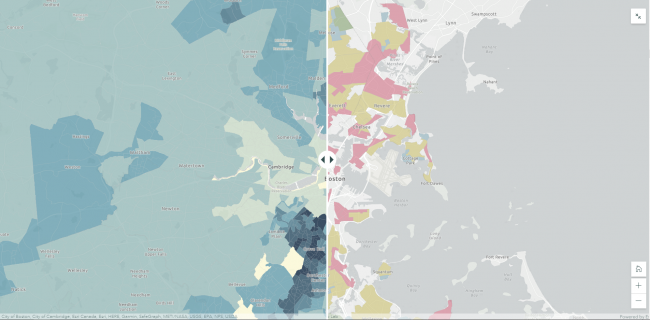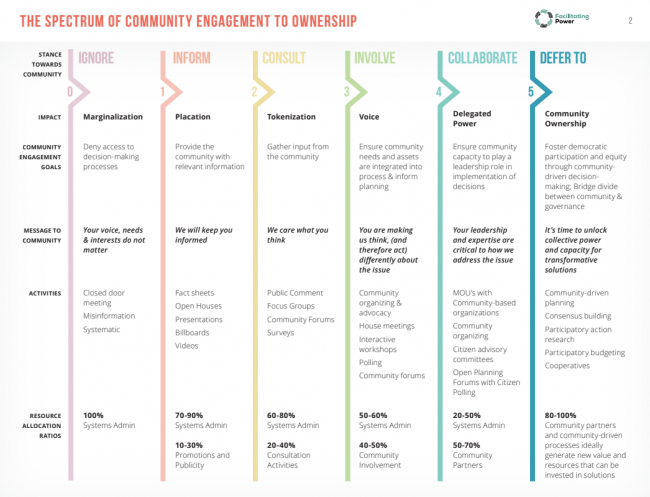

By Emme Luck | Thu, February 24, 22
As energy efficiency leaders embark on the journey to make more equitable decisions, it is critical to understand the landscape of energy inequities in one's jurisdiction before moving to solutions. This blog will outline NEEP's newest resources – a story map, brief, and glossary – on implementing equitable policies. These resources identify the state of energy inequities in the Northeast and Mid-Atlantic and provide guidance to implement equitable decarbonization policies and programs. The StoryMap, Recognizing Energy Inequities for Building Decarbonization, provides an overview of the barriers faced by historically marginalized or excluded communities. The brief, Near-Term Solutions for Centering Energy Equity, identifies pathways towards a more equitable application of energy efficiency solutions. The Glossary defines key terms for both resources and serves as a foundation for NEEP's equity work.
In order to create these tools, NEEP reviewed existing resources and interviewed almost 20 stakeholders in program administration, policy development, and community advocacy. We hope that these companion pieces can serve as a foundation to implementing equitable energy policy in the future. Below is a preview of each.
The StoryMap: Recognizing Energy Inequities for Building Decarbonization
Understanding energy inequities and the practices that exacerbate them is the first step to centering equity in decarbonizing our buildings. The StoryMap does this by walking through historical and current policies that contribute to energy inequity. In the “Understanding Energy Equity” section, we explore the root causes of inequity by describing the historical policies that lead to energy insecurities faced by historically marginalized or excluded communities. In the “Exacerbating Inequities” section, we identify current policies and practices that continue to worsen them.
Many existing building decarbonization efforts may fall short of achieving equity due to the inherent structural racism and classism in our systems and policies. Redlining and segregation, income inequalities, and aging housing stock are some "root" causes of energy inequities. In order to create more thoughtful policies today, policymakers must understand how these root causes have contributed to energy inequities. For example, through the action of redlining, historical decision-makers relegated people of color to areas with substandard housing and proximity to pollution sites. This contributed to the subsequent segregation of our communities and disinvestment in communities of color. Not only do redlined areas often have less green space, higher surface temperatures, higher utility costs, and lower housing values, they are also more likely to have lower quality and less efficient housing. These repercussions stem from the act of redlining.
While the root causes of inequities often boil down to racism and/or classism, there are many exacerbating factors that worsen existing inequities in the energy efficiency space. This StoryMap investigates a few of the causes most pertinent to building decarbonization, from how utilities rates are structured and ways programs are designed to workforce inequities and the treatment of homes that are rented or manufactured. These issues are standard practice in the energy efficiency industry today, but must be reconsidered to center energy equity.
The Brief: Near-Term Solutions for Centering Energy Equity
The accompanying brief explores near-term solutions for centering energy equity to ensure healthy, affordable, and sustainable buildings for all residents of our region. While centering equity requires deep, systems-level change, there are several near-term opportunities for advancing energy equity which decision-makers can take as first steps. The brief identifies these pathways by sharing scalable best practices from states, communities, and groups tackling these issues. Topics include creating an avenue for meaningful participation with equity committees and developing metrics to value non-energy benefits and hold program implementers accountable.
A key first step towards implementing all of these changes is integrating voices of historically marginalized communities into energy efficiency work and planning processes and sharing decision-making power with those communities so that they can build wealth and resilience. Equity committees, such as the Providence Racial and Environmental Justice Committee, can create avenues for meaningful participation from all community representatives, which is necessary to create equitable and effective programs and policies that ultimately serve all constituents. Equity committees can also help decision-makers to move along the Spectrum of Community Engagement to Ownership, in which community ownership means that leaders share their power and defer to community members for decision-making.
The brief also highlights changes that can be made to program administration and implementation to create more equitable programs, such as impact assessments and metrics. Racial equity and/or health impact assessments are an important first step to understanding potential intended and unintended consequences of a project. The brief provides examples of where and how these assessments are being used, and toolkits for conducting them. Additionally, the brief presents approaches to measuring equity and developing metrics for understanding the efficacy of programs and impacts. It also provides guidance on integrating equity metrics into cost-benefit analyses and evaluation, measurement, and verification processes.
Finally, the brief highlights how to put residents first and how to develop an equitable and sustainable workforce. Putting resident needs at the center of program design and workforce investment is essential to ensure access to these opportunities. Underpinning all energy efficiency programs is a community of companies and workers who face numerous new opportunities as these programs grow. Without accountability, this workforce could perpetuate existing inequities in the industry. An equitable and sustainable workforce is needed to maintain several program models key for implementing energy equity: comprehensive weatherization services, energy standards, and resident protection policies can be employed to reduce energy burden and create healthier and more comfortable indoor environments. At the same time, we must develop our workforce to support the implementation of these programs and policies.
Conclusion
Together, these resources aim to help energy efficiency policy- and decision-makers make more equitable, inclusive policies and share decision-making power with the communities they serve. By recognizing past injustices, identifying current policies that exacerbate inequities, and identifying near-term solutions, we can begin to build energy equity. While progress has been made and near-term solutions are attainable, there is much work to be done to achieve energy equity in the Northeast and Mid-Atlantic region.



